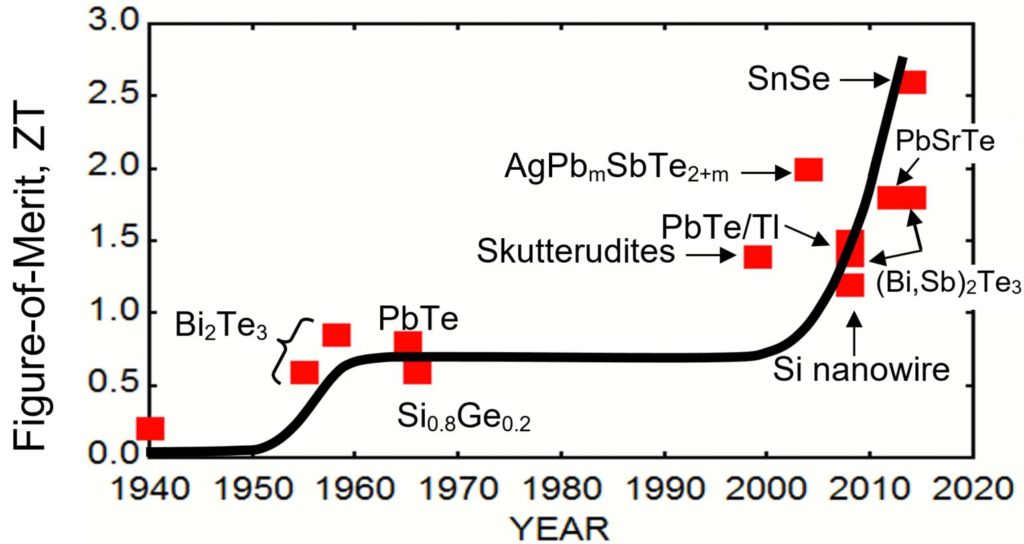During the last decade, significant progress was made in fundamental understanding of mechanisms that led to thermoelectric materials with high figure-of-merit ZT (Figure 1). It was proposed and subsequently demonstrated that nanostructuring of the semiconductor material could provide a significant improvement. The technique was implemented in different forms including bulk nanocomposites,[i],[ii],[iii],[iv] complex structures,[v],[vi],[vii] superlattices,[viii],[ix],[x] and low dimensional forms.[xi] These findings stimulated rapid progress in synthesizing high-ZT materials during the last decade.
Despite the concentrated efforts on improving the material zT, little attention was given to fundamental innovations in device design and architecture. Consequently, manufacturing of the present day bulk thermoelectric modules is not very different than how they were manufactured decades ago. It is believed that the next level of advancements in thermoelectric modules will come from advanced device architectures that can enable new applications.

Figure 2: NCSU Nanofabrication Facility (NNF) houses all standard thin film processing tools including Raith 150 Two Electron Beam Lithography System.
We are pursuing two directions:
(1) development of novel thin-film thermoelectric device structures and
(2) development of solar-enhanced thermoelectric cells for IoT applications.
The novel micro power generator consists of several thousands of microscale thermoelectric elements per square centimeter compared to the conventional devices which consist only dozens of millimeter-scale elements. Therefore, the new device can generate >1000X larger output voltage. It achieves this performance enhancement thanks to an entirely new device architecture. This research aims to develop a CMOS compatible, wafer-scale micro-fabrication process to fabricate these micro thermoelectric generators on inexpensive silicon wafers. The fabrication will rely on mature processes and techniques used in micro-electro-mechanical-systems integration.
References:
[[i]] Z Zamanipour, X Shi, AM Dehkordi, JS Krasinski, D Vashaee, “The effect of synthesis parameters on transport properties of nanostructured bulk thermoelectric p‐type silicon germanium alloy”, physica status solidi (a) 209 (10), 2049-2058 (2012)
[[ii]] Z. Zamanipour, D. Vashaee, “Comparison of thermoelectric properties of p-type nanostructured bulk Si0. 8Ge0. 2 alloy with Si0. 8Ge0. 2 composites embedded with CrSi2 nano-inclusions”, Journal of Applied Physics 112 (9), 093714-093714-9 (2012)
[[iii]] N. Satyala, D. Vashaee, “The effect of crystallite size on thermoelectric properties of bulk nanostructured magnesium silicide (Mg2Si) compounds”, Applied Physics Letters 100 (7), 073107-073107-4 (2012)
[[iv]] Z. Zamanipour, E. Salahinejad, P. Norouzzadeh, J. S. Krasinski, L. Tayebi, & D. Vashaee, “The effect of phase heterogeneity on thermoelectric properties of nanostructured silicon germanium alloy”, Journal of Applied Physics, 114(2), 023705-023705 (2013).
[[v]] G.J. Snyder, E.S. Toberer, “Complex thermoelectric materials”, Nat. Mater., 7(2),105-14, doi: 10.1038/nmat2090 (2008)
[[vi]] P. Norouzzadeh, C.W. Myles, D. Vashaee, “Prediction of a large number of electron pockets near the band edges in type-VIII clathrate Si46 and its physical properties from first principles”, Journal of Physics: Condensed Matter 25 (47), 475502 (2013)
[[vii]] M. Dresselhaus, G. Chen, Z. Ren, J.P. Fleurial, P. Gogna, M.Y. Tang, D. Vashaee, H. Lee, X. Wang, G. Joshi, G. Zhu, D. Wang, R. Blair, S. Bux, R. Kaner, “Nanocomposites to enhance ZT in thermoelectrics”, MRS Proceedings 1044 (1) (2007)
[[viii]] D. Vashaee, Y. Zhang, A. Shakouri, G. Zeng, Y.J. Chiu, “Cross plane Seebeck coefficient in superlattice structures in miniband conduction regime”, Physical Review B 74 (19), 195315 (2006)
[[ix]] D. Vashaee, A. Shakouri, “Improved thermoelectric power factor in metallic based superlattices”, Physical Review Letters 92 (10), 106103 (2004)
[[x]] D. Vashaee, A. Shakouri, “Non-equilibrium electrons and phonons in heterostructure integrated thermionic coolers”, Microscale Thermophysical Engineering 8 (2), 91-100 (2004)
[[xi]] Y.M. Lin & M.S. Dresselhaus, “Thermoelectric properties of superlattice nanowires”, Physical review B, 68(7), 075304 (2003)
